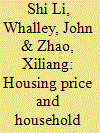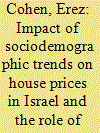|
|
|
Sort Order |
|
|
|
Items / Page
|
|
|
|
|
|
|
| Srl | Item |
| 1 |
ID:
121805


|
|
|
|
|
| Publication |
2013.
|
| Summary/Abstract |
This article investigates the effect of house prices on household savings rates in urban China employing the 2002 and 2007 data of the Chinese Households Income Project (CHIP). We find that the rapid appreciation of house prices cannot explain high Chinese households' savings rates and the rising of Chinese savings rates. On the contrary, we find a negative relationship between house prices and household savings rates for home renters and homeowners. We do not find any evidence of 'savings for housing purchase' for young home renters when house prices increase. Their savings rates declined during housing market booms in recent 10?years. Savings rates of homeowners possessing multiple housing have decreased more because of 'the pure housing wealth effects.'
|
|
|
|
|
|
|
|
|
|
|
|
|
|
|
|
| 2 |
ID:
183995


|
|
|
|
|
| Summary/Abstract |
This article examines the impact of sociodemographic trends in marriage, divorce, and rising life expectancy in different districts in Israel on the increase in the number of households and, in turn, on the rising house prices in each of the districts. The findings show that in 2008–17, the Tel Aviv, Jerusalem, and Central districts, which had higher marriage, divorce, and life expectancy rates compared to other districts not only had the largest annual increment in the total number of households but also saw a particularly steep rise in house prices compared to a more moderate rise in the other districts and outlying areas. This state of affairs requires the formulation of a public policy capable of influencing demand and supply pressures in the house market in the various districts, with the aim of regulating house prices in accordance with national needs and government strategies for spreading the population throughout the country.
|
|
|
|
|
|
|
|
|
|
|
|
|
|
|
|
| 3 |
ID:
113691


|
|
|
|
|
| Publication |
2012.
|
| Summary/Abstract |
The high and rising house prices in China are not adequately accounted for the traditional explanations emphasizing demand-driven or cost-push factors. Recent published studies claim that gender imbalance increases competition among men in the marriage market, which has pushed Chinese, especially parents with a son, to buy houses as a signal of relative status in the marriage market; this marriage competition then causes high demand for houses and eventually leads to rising house prices in China. Empirical results in this paper, however, provide little support for this hypothesis and we find that a rise in the sex ratios for most age cohorts accounts for very small percentage variations in house price movements in China during 1998-2009. Further investigation suggests that excess demand driven by high monetary growth was a significant cause of the rising house prices in China during 1998-2009. Therefore, the impact of gender imbalance on house prices should not be exaggerated and monetary dynamics remains an important leading indicator for house price movements in China.
|
|
|
|
|
|
|
|
|
|
|
|
|
|
|
|
| 4 |
ID:
180135


|
|
|
|
|
| Summary/Abstract |
This paper examines the effect of wind turbines and solar farms on house prices. Using detailed data from the Netherlands between 1985 and 2019, the results show that tall wind turbines have considerably stronger effects on house prices, as compared to small turbines. For example, a tall turbine (>150m) decreases house prices within 2 km by , while a small turbine (<50m) has an effect of maximally and the effect dissipates after 1 km. Further results indicate that solar farms lead to a decrease in house prices within 1 km of about . By comparing the overall impact on house prices, we show that the external effects of solar farms per unit of energy output are comparable to those of wind turbines. Thus, building solar farms instead of wind turbines does not seem to be a way to avoid the external effects of renewable energy production.
|
|
|
|
|
|
|
|
|
|
|
|
|
|
|
|
|
|
|
|
|